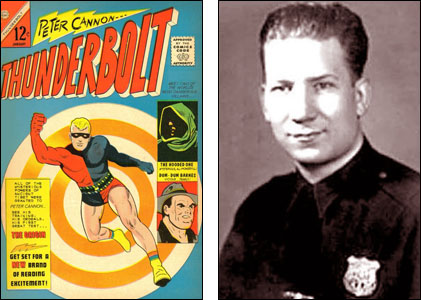Pete Morisi, known to fans of Charlton comics as "P.A.M.," died yesterday at Staten Island University Hospital. So far, we've heard nothing about a cause of death but I'll tell you what I can about his life and times. Peter A. Morisi was born in the Park Slope area of Brooklyn in 1928 and grew up there, dreaming of being either a policeman or a comic book artist. He opted for the latter and wound up studying, like about half the comic artists of his generation, at the School of Industrial Arts in New York. He occasionally assisted on newspaper strips (Dickie Dare, The Saint and the Dan Barry Flash Gordon) but devoted most of his career to comic books and another, unrelated occupation, which we'll get to. His first comic book work appears to have been for Fox Comics in 1948, where he sold a few stories before being drafted into the Army.
While stationed in Colorado, he wrote a number of scripts for that company's romance and crime comics, and even managed to draw a few stories, including a short-lived strip called "Lionus the Cruel." Upon his return to New York in 1950, he worked for Quality Comics, Timely (now Marvel), Harvey, Lev Gleason, Fiction House and several other companies. In 1953, he wrote and drew a detective strip called "Johnny Dynamite" for Comic Media. It failed to click with readers but attracted a strong following among professionals and the admiration of his fellow artists.
Morisi's early work in comics showed a lot of Alex Raymond influence but one day, he made a sharp turn. Reportedly, an editor told him to try and draw more like George Tuska, who was then the "star" artist in the field of crime comics. Morisi liked Tuska's work and saw that others were emulating the man, but felt it was wrong to simply appropriate someone else's style. So, the story goes, he phoned up Tuska, asked if he could imitate his approach and offered to pay a small royalty for the privilege. Tuska was so amazed that anyone had asked that he gave Morisi permission to draw like him and waived the fee. Thereafter, some of Morisi's work was so close to Tuska's in style that when they worked for the same firm, the editor got them confused.
In the mid-fifties, there was a recession in the comic book field and publishers began closing. Morisi saw where it was all headed and decided he needed another line of work. Fulfilling his other childhood dream, he studied for and joined the New York Police Department in 1956. He put in twenty years on the force, most of it spent working in Brooklyn and lower Manhattan. But he didn't stop working for comics. He just stopped signing his work…or he'd sign it "P.A.M.," so that the N.Y.P.D. wouldn't know of his moonlighting. Except for one brief job for Classics Illustrated and a few jobs for DC in the early seventies, all of his comic book work was done for Charlton, primarily on westerns. These included Billy the Kid, Gunmaster, Wyatt Earp and Kid Montana. Though Charlton paid rock-bottom wages, the company was willing to allow him to work without deadlines. He'd write and draw his own stories (or accept a script which he would only draw) at his own pace in whatever time he had away from the police beat. Whenever he got one done, they'd accept it and pay him. It worked out well for both sides and Morisi was one of their more talented contributors.
His most memorable work, however, came during a brief period in the sixties when editor Dick Giordano attempted to launch an "action hero" line and asked Morisi to come up with one. Morisi created Peter Cannon, Thunderbolt — an uncommonly thoughtful super-hero comic which delved into Eastern philosophies and martial arts at a time when such areas were relatively new to American media. The first issue appeared in January of 1966 and made a huge hit with fans. Unfortunately, Morisi was unable to produce material on the kind of deadline necessary for a recurring feature. Others had to fill-in for him and after only eight issues, he had to abandon his creation and return to non-series stories, mostly for westerns or ghost comics such as The Many Ghosts of Dr. Graves. He did not attempt another regular strip until 1975 as he neared retirement from the N.Y.P.D. Then, he created, wrote and drew Vengeance Squad, which dealt with a crew of private detectives who used fisticuffs and high-tech means (though rarely firearms) to solve crimes and catch criminals that stymied the police. The book only lasted six issues — and Charlton didn't last much longer. Had readers known the comic was the work of a cop with twenty years on the force, it might have meant more.
Morisi retired from police work in 1976 but did very little in comics after that. His wife of 53 years passed away last May so he is survived by three sons (Steven, Russ and Val), a brother, a sister and five grandchildren. Services are Thursday at the Richmond Funeral Home in Grant City.
I never had the pleasure of meeting Mr. Morisi in person but we spoke several times on the phone. He was a modest man who cared deeply about a select group of artist friends. He was always calling to check on them and see if he could assist with advice or work referrals, or even to loan them money. One time we spoke, I asked him if during all his years as a cop, he ever had to arrest anyone he knew from the comic book business. He chuckled and replied, "No…but I can think of a few guys who should have been doing hard time."
